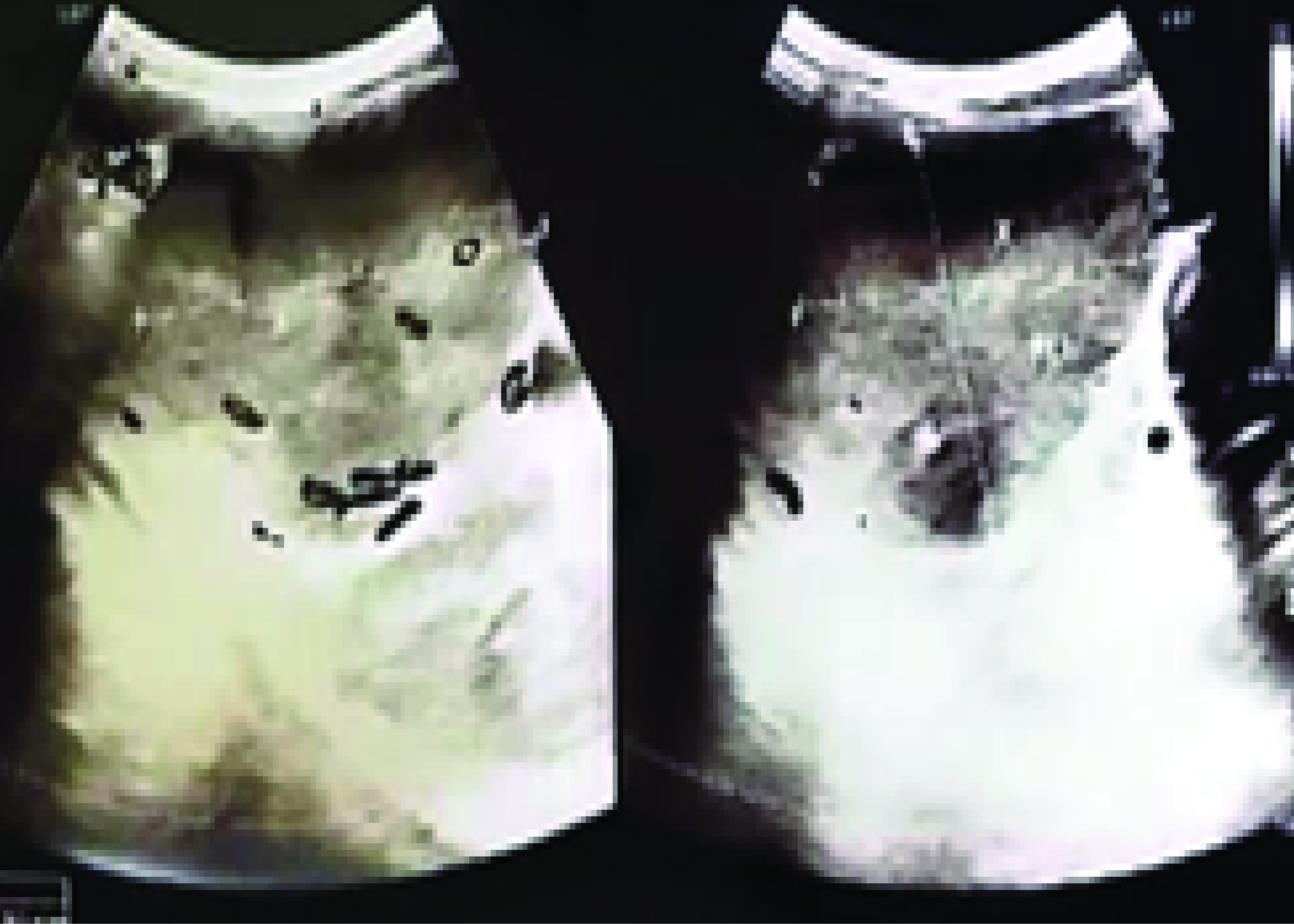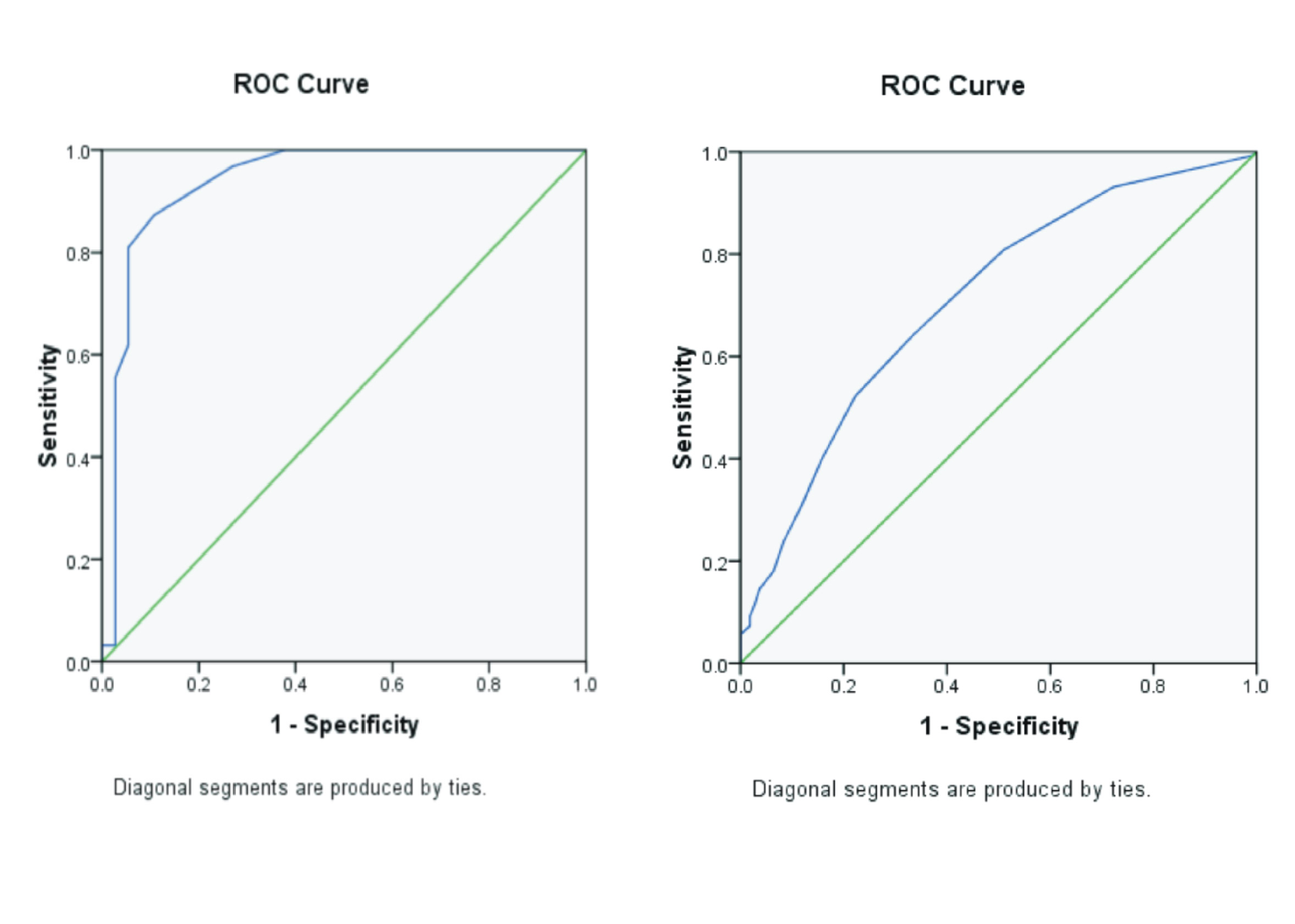LIVER CANCER ASSOCIATED WITH HEPATITIS B VIRUS INFECTION IN A CHILD: A CASE REPORT

Background: Two-thirds of primary liver tumors in children are malignant. Hepatoblastoma (HBL) accounts for 40-60 percent of pediatric liver tumors and is the most common malignant liver tumor. Hepatocellular Carcinoma (HCC) is the second most common malignancy in children, accounting for approximately 20% of cases. Both malignant liver tumors have similar clinical and imaging features, but different prognosis and treatment. Purpose: This report aims a case of liver cancer related to hepatitis B virus infection in a child. Case analysis: A 15-year-old girl presented with a two-month history of right upper quadrant pain along with abdominal distension, weight loss, back pain, anorexia, nausea, weakness and fatigue for 5 months prior to admission. Physical examination revealed a hard, firm mass with a bumpy surface in the right upper quadrant of the abdomen and splenomegaly. Laboratory test showed an increase in Lactate Dehydrogenase (LDH), Gamma-Glutamyl Transpeptidase (GGT), Alpha Feto Protein (AFP), quantitative Hepatitis B Virus (HBV) DNA, and HBsAg reactive. Abdominal Multi-Slice Computed Tomography (MSCT) revealed malignant solid mass with necrotic component inside, indistinct borders, irregular margins and kissing spleen. Result: The diagnosis of liver cancer in this patient suggested HCC associated with chronic hepatitis B infection. Conclusion: Routine follow-up of all children with chronic hepatitis B infection is crucial because of the risk of developing liver cancer in adolescence and adulthood.
Introduction
Pediatric liver cancer often develops in otherwise healthy livers and generally carries a poor prognosis. This liver cancer may be associated with congenital abnormalities, genetic syndromes or metabolic conditions. Hepatoblastoma (HBL) and Hepatocellular Carcinoma (HCC) are two major neoplasms accounting for 0.5 - 1.5% of all pediatric neoplasms. These two neoplasms also account for 4% of all Orthotopic Liver Transplants (OLT) in children. Hepatoblastoma accounts for 67-80% of all childhood liver cancers worldwide, while HCC accounts for 20-33%. The incidence of HCC depends on geographic and demographic factors and is related to the incidence of hepatitis B in the population(Khanna & Verma, 2018). Childhood HCC has a poor prognosis, with less than 30% disease-free survival compared to HBL, which has over 80% disease-free survival(Digiacomo et al., 2023).
Hepatocellular Carcinoma (HCC) is the second most common primary liver malignancy in children after HBL, accounting for approximately 27% of cases. The remaining pediatric promary liver malignancy cases are vascular tumors and sarcomas. Overall primary liver malignancies are extremely rare, accounting for only 1% of all pediatric malignancies, with less than 1.5 cases per million in children under age of 18. Hepatoblastoma accounts for more than two-thirds of these cases, with HCC and the very rare embryonal sarcoma of the liver accounting for the other cases. Hepatocellular Carcinoma occurs mostly in older children and adolescents, either in a noncirrhotic liver or associated with various fibrosing diseases or cirrhosis of varying etiology(Ranganathan et al., 2020).
A total of 257 - 291 million people worldwide are chronically infected with Hepatitis B Virus (HBV), but may remain asymptomatic for many years. However, they can potentially transmit the infection to others by perinatal, percutaneous, and sexual exposure or by close person-to-person contact. Complications such as cirrhosis, liver failure, and HCC, which are the leading causes of HBV-related death, are estimated to occur in 15 - 40% of HBV-infected patients(Lim et al., 2020),(Tajiri et al., 2016)World Health Organization (WHO) has committed to eliminating HBV, but this is difficult to achieve due to social barriers, including stigma, embarrassment, denial, isolation, and depression, that cause chronic HBV patients to conceal their infection and not seek treatment(Roma et al., 2024). This report aims to discuss a case of liver cancer associated with hepatitis B virus infection in a child. Serious complications from hepatitis B in children are well established, therefore early prevention of hepatitis B should be implemented.
Case study
A 15-year-old girl presented to the Pediatric Outpatient Clinic with Right Upper Quadrant (RUQ) pain for 2 months and other symptoms, including abdominal distention, back pain, weight loss, anorexia, nausea, general weakness, and fatigue for 5 months prior to admission. Data revealed that the patient’s maternal grandmother had died several years ago from liver cancer, and the patient's biological mother had also suffered from HBV infection, with seropositive results on HBsAg blood examination. Previously, the patient had been taken to the local regional hospital, where a serological examination also revealed positive serology HBsAg results. The family has been advised to seek further management. However, due to the pandemic, the patient’s family postponed the follow-up. The patient’s physical examination showed abdominal distension, splenomegaly without venous dilatation. In the right upper quadrant of the abdomen, a hard, solid mass with an irregular surface pas palpable.
Result
The complete blood count revealed anemia (Hb 7.6 g/dL, Hct 22.6%, leucocyte 8.81x10³/μL, thrombocyte 526x10³/μL). Liver function tests showed elevated Aspartate Aminotransferase (AST) 348 U/L, normal Alanine Aminotransferase (ALT) 29 U/L, elevated Lactate Dehydrogenase (LDH) 252 U/L, HBsAg reactive >1.000, Alkaline phosphatase (ALP) 171 U/L, Gamma-Glutamyl Transpeptidase (GGT) 215 U/L, Alpha Feto Protein (AFP) >1.000 IU/ml, and HBV DNA 364 copies/ml (Log 2.56). Abdominal ultrasound showed a normal-sized liver with a hypoechoic lesion measuring 6.2 x 5.2 x 7.1 cm in segments 5 - 6 of the right lobe, vascularization within the lesion (+), and suspicion of a right lobe hepatoma in segment 5 - 6 can be seen inFigure 1. After admission, chest x-ray was performed due to shortness of breath. Rough nodules were seen on both lungs, suggesting metastatic process to the lungs can be seen inFigure 2.
A real-time Multi-Slice Computed Tomography (MSCT) scan of the abdomen revealed a liver enlargement with a mean craniocaudal length of approximately 25.56 cm, resulting in a kissing spleen. A solid mass (38 - 41 HU) with a necrotic component in the interior (25 HU), ill-defined margins, irregular borders ± 13.7 x 17.2 x 25.56 cm was identified in the right lobe. In segment II of the left lobe, the largest size of approximately 2.2 x 2.1 x 3.5 cm showed contrast enhancement (93 HU). The lesion seemed to be nourished by the right and left hepatic artery. Additionally, a mass was found pressing the right kidney posteriorly, no thrombus or AV fistula was observed (Figure 3). Based on the patient’s history, physical examination, laboratory findings and radiological results, HCC was suspected. Liver biopsy was not performed due to the clinical condition. Supportive care was initiated with packed red blood cell transfusion and oxygen supplementation.
Figure 1.Abdominal ultrasonography showed hypoechoic lesion
Figure 2.Chest radiograph showed rough nodules on both lungs
Figure 3.Multi Slice Computed Tomography (MSCT) scan of the abdomen revealed a liver enlargement with solid mass
Discussion
Liver tumors account for approximately 1% of all
Alemayehu, T., Hailu, D., 2019. Hepatocellular Carcinoma with Vertebral Metastasis in A Child with Hepatitis B Virus Infection: A Case Report. Journal of Medical Case Reports Vol. 13(1), Pp. 158.
Alshareefy, Y., Shen, C.Y., Prekash, R.J., 2023. Exploring The Molecular Pathogenesis, Diagnosis and Treatment of Fibrolamellar Hepatocellular Carcinoma: A State of Art Review of The Current Literature. Pathology, Research and Practice Vol. 248, Pp. 154655.
Borgia, G., Carleo, M.A., Gaeta, G.B., Gentile, I., 2012. Hepatitis B in Pregnancy. World Journal of Gastroenterology Vol. 18(34), Pp. 4677-4683.
Brusset, B., Jacquemin, M., Teyssier, Y., Roth, G.S., Sturm, N., Roustit, M., Bône, A., Ghelfi, J., Costentin, C.E., Decaens, T., 2024. Radiological Diagnosis of Hepatocellular Carcinoma does not Preclude Biopsy before Treatment. JHEP Reports: Innovation in Hepatology Vol. 6(1), Pp.100957.
Camara, M., Tantuoyir, M.M., SeyedAlinaghi, S., Ghiasvand, F., Ahmadinejad, Z., 2023. Prevalence of Hepatitis B Infection in The Gambian Population: A Narrative Review of Recent Developments. Preventive Medicine Reports Vol. 36, Pp. 102401.
Filippo Villa di, D., Navas, M.-C., 2023. Vertical Transmission of Hepatitis B Virus - An Update. Microorganisms Vol. 11(5), Pp. 1140.
Digiacomo, G., Serra, R.P., Turrini, E., Tiri, A., Cavazzoni, A., Alfieri, R., Bertolini, P., 2023. State of The Art and Perspectives in Pediatric Hepatocellular Carcinoma. Biochemical Pharmacology Vol. 207, Pp. 115373.
Du, Z., Yin, S., Liu, B., Zhang, W., Sun, J., Fang, M., Xu, Y., Hua, K., Tu, P., Zhang, G., Ma, Y., Lu, Y., 2023. Metabolomics and Network Analysis Uncovered Profound Inflammation-Associated Alterations in Hepatitis B Virus-Related Cirrhosis Patients with Early Hepatocellular Carcinoma. Heliyon Vol. 9(5), Pp. e16083.
Felden, J. Von, Schulze, K., Krech, T., Ewald, F., Nashan, B., Pantel, K., Lohse, A.W., Riethdorf, S., Wege, H., 2017. Circulating Tumor Cells as Liquid Biomarker for High HCC Recurrence Risk after Curative Liver Resection. Oncotarget Vol. 8(52), Pp. 89978-89987.
Hu, Y., Wu, X., Ye, Y., Ye, L., Han, S., Wang, X., Yu, H., 2022. Liver Histology of Treatment-Naïve Children with Chronic Hepatitis B Virus Infection in Shanghai China. International Journal of Infectious Diseases: IJID: Official Publication of The International Society for Infectious Diseases Vol. 123, Pp. 112-118.
Indolfi, G., Easterbrook, P., Dusheiko, G., Siberry, G., Chang, M.-H., Thorne, C., Bulterys, M., Chan, P.-L., El-Sayed, M.H., Giaquinto, C., Jonas, M.M., Meyers, T., Walsh, N., Wirth, S., Penazzato, M., 2019. Hepatitis B Virus Infection in Children and Adolescents. The Lancet. Gastroenterology & Hepatology Vol. 4(6), Pp. 466-476.
Khanna, R., Verma, S.K., 2018. Pediatric Hepatocellular Carcinoma. World Journal of Gastroenterology Vol. 24(35), Pp. 3980-3999.
Lee, W.M., 1997. Hepatitis B Virus Infection. New England Journal of Medicine Vol. 337(24), Pp. 1733-1745.
Lim, J.K., Nguyen, M.H., Kim, W.R., Gish, R., Perumalswami, P., Jacobson, I.M., 2020. Prevalence of Chronic Hepatitis B Virus Infection in The United States. The American Journal of Gastroenterology Vol. 115(9), Pp. 1429-1438.
Mogul, D.B., Ling, S.C., Murray, K.F., Schwarzenberg, S.J., Rudzinski, E.R., Schwarz, K.B., 2018. Characteristics of Hepatitis B Virus-Associated Hepatocellular Carcinoma in Children: A Multi-Center Study. Journal of Pediatric Gastroenterology and Nutrition Vol. 67(4), Pp. 437-440.
Morais, E., Mason, L., Dever, J., Martin, P., Chen, J.V., Felton, L., Kendrick, S., Theodore, D., Gillespie, I.A., 2023. Clinical Consequences of Hepatitis B Surface Antigen Loss in Chronic Hepatitis B Infection: A Systematic Literature Review and Meta-Analysis. Gastro Hep Advances Vol. 2(7), Pp. 992-1004.
Murawski, M., Weeda, V.B., Maibach, R., Morland, B., Roebuck, D.J., Zimmerman, A., Casanova, M., Perilongo, G., Laithier, V., Kebudi, R., Scopinaro, M.J., Shun, A., Brichard, B., de Camargo, B., Childs, M., Aronson, D.C., Czauderna, P., 2016. Hepatocellular Carcinoma in Children: Does Modified Platinum- and Doxorubicin-Based Chemotherapy Increase Tumor Resectability and Change Outcome? Lessons Learned from the SIOPEL 2 and 3 Studies. Journal of Clinical Oncology: Official Journal of the American Society of Clinical Oncology Vol. 34(10), Pp. 1050-1056.
Pinto, E., Meneghel, P., Farinati, F., Russo, F.P., Pelizzaro, F., Gambato, M., 2024. Efficacy of Immunotherapy in Hepatocellular Carcinoma: Does Liver Disease Etiology Have A Role? Digestive and Liver Disease. Digestive and Liver Disease Vol. 56(4), Pp. 579-588.
Ranganathan, S., Lopez-Terrada, D., Alaggio, R., 2020. Hepatoblastoma and Pediatric Hepatocellular Carcinoma: An Update. Pediatric and Developmental Pathology: The Official Journal of the Society for Pediatric Pathology and the Paediatric Pathology Society Vol. 23(2), Pp. 79-95.
Roberts, S.K., Majeed, A., Kemp, W., 2021. Controversies in The Management of Hepatitis B: Hepatocellular Carcinoma. Clinics in Liver Disease Vol. 25(4), Pp. 785-803.
Roma, K., Chandler, T.-M., Dossaji, Z., Patel, A., Gupta, K., Minacapelli, C.D., Rustgi, V., Gish, R., 2024. A Review of The Systemic Manifestations of Hepatitis B Virus Infection, Hepatitis D Virus, Hepatocellular Carcinoma, and Emerging Therapies. Gastro Hep Advances Vol. 3(2), Pp. 276-291.
Tajiri, H., Takano, T., Tanaka, H., Ushijima, K., Inui, A., Miyoshi, Y., Ozono, K., Abukawa, D., Endo, T., Brooks, S., Tanaka, Y., 2016.
Hepatocellular Carcinoma in Children and Young Patients with Chronic HBV Infection and The Usefulness of Alpha-Fetoprotein Assessment. Cancer Medicine Vol. 5(111), Pp. 3102-3110.
Yang, T., Lu, J.-H., Lin, C., Shi, S., Chen, T.-H., Zhao, R.-H., Wang, Y., Wu, M.-C., 2012. Concomitant Lung Metastasis In Patients With Advanced Hepatocellular Carcinoma. World Journal of Gastroenterology Vol. 18(20), Pp. 2533-2539.
Yantie, N.V.K., Ariawati, K., Sanjaya, I.G.N., 2016. Karsinoma Hepatoselular pada Anak Usia 11 Tahun. Sari Pediatri Vol. 13(3), Pp. 179-84.
Yeh, S.-H., Li, C.-L., Lin, Y.-Y., Ho, M.-C., Wang, Y.-C., Tseng, S.-T., Chen, P.-J., 2023. Hepatitis B Virus DNA Integration Drives Carcinogenesis and Provides a New Biomarker for HBV-related HCC. Cell Mol Gastroenterol Hepatol Vol. 15(4), Pp. 921-929.
Yin, Y., Wu, L., Zhang, J., Zhou, J., Zhang, P., Hou, H., 2013. Identification of Risk Factors Associated with Immunoprophylaxis Failure to Prevent The Vertical Transmission of Hepatitis B Virus. The Journal of Infection Vol. 66(5), Pp. 447-452.
Zhao, P., Lu, Y., Wang, C., Wang, L., Li, J., Li, M., 2021. Clinical, Pathological and Genetic Characteristics of Pediatric Hepatocellular Carcinoma Associated with Hepatitis B Virus Infection. Journal of Hepatocellular Carcinoma Vol. 8, Pp. 361-367.
Zhuang, H., Peng, Y., Chen, T., Jiang, Y., Luo, Y., Zhang, Q., Yang, Z., 2011. The Comparison of Grey-Scale Ultrasonic and Clinical Features of Hepatoblastoma and Hepatocellular Carcinoma in Children: A Retrospective Study for Ten Years. BMC Gastroenterology Vol. 11(1), Pp. 78.
Ziogas, I.A., Ye, F., Zhao, Z., Matsuoka, L.K., Montenovo, M.I., Izzy, M., Benedetti, D.J., Lovvorn, H.N., Gillis, L.A., Alexopoulos, S.P., 2020. Population-Based Analysis of Hepatocellular Carcinoma in Children: Identifying Optimal Surgical Treatment. Journal of The American College of Surgeons Vol. 230(6), Pp. 1035-1044.e3.
Zou, H., Chen, Y., Duan, Z., Zhang, H., Pan, C., 2012. Virologic Factors Associated with Failure to Passive - Active Immunoprophylaxis in Infants Born to Hbsag‐Positive Mothers. Journal of Viral Hepatitis Vol. 19(2), Pp. e18-25.
Copyright (c) 2025 Journal of Vocational Health Studies

This work is licensed under a Creative Commons Attribution-NonCommercial-ShareAlike 4.0 International License.
- The authors agree to transfer the transfer copyright of the article to the Journal of Vocational Health Studies (JVHS) effective if and when the paper is accepted for publication.
- Legal formal aspect of journal publication accessibility refers to Creative Commons Attribution-NonCommercial-ShareAlike (CC BY-NC-SA), implies that publication can be used for non-commercial purposes in its original form.
- Every publications (printed/electronic) are open access for educational purposes, research, and library. Other that the aims mentioned above, editorial board is not responsible for copyright violation.
Journal of Vocational Health Studies is licensed under a Creative Commons Attribution-NonCommercial-ShareAlike 4.0 International License














































